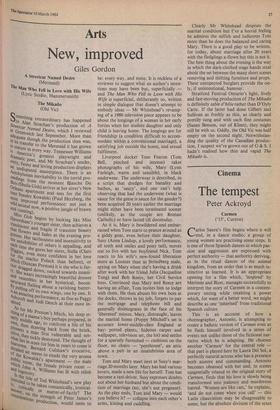Cinema
The tempest
Peter Ackroyd
Carmen ('15', Curzon)
Carlos Saura's film begins where it will /4—/end, in a dance studio; a group of young women are practising some steps. It is one of those Spanish dances in which pas- sion and aggression are expressed with perfect authority — that authority deriving, as in the ritual dances of the animal kingdom, from an order that is as much in- stinctive as learned. It is an appropriate opening for a film which, 'inspired' by Merimee and Bizet, manages successfully to interpret the story of Carmen in a contem- porary setting while retaining a power which, for want of a better word, we might describe as one 'inherited' from traditional Spanish culture.
This is an account of how a choreographer, Antonio, is attempting to create a balletic version of Carmen even as he finds himself involved in a series of events not unlike those of the fictional nar- rative which he is adapting. He chooses another 'Carmen' for the central role that part is played here by Laura Del Sol, a perfectly natural actress who has a presence both austere and commanding. Antonio becomes obsessed with her and, in scenes tangentially related to the original story of Carmen, finds that his love is slowly being transformed into jealousy and murderous hatred. 'Women are like cats,' he explains, 'and do not come when you call' — this Latin chauvinism may be disagreeable to some, but the absolute division of the sexes is necessary for the drama — it is, after all, a reflection of male helplessness in the face of overpowering love, and 'machismo' itself is only a defence against the power of the woman to dominate the man. It is a sim- ple narrative, perhaps, but one capable of dramatic elaboration on a sensational scale — rendered more interesting here as the distinction between the real passions of the characters and the rehearsed emotions of their roles becomes more and more am- biguous. We seem to be watching a 'real' scene only to discover that it is in fact part of the ballet, and the closing sequence of the film is left in some indeterminate space between life and art.
Carmen is filled with Bizet's music which, in similar fashion, adds a deeper note to the contemporary flamenco guitar. And the symbolic image of Carmen herself — hair like raven's feathers, eyes like a wolf's — hovers over the film like some diva abscondita. When this image of romantic beauty is aligned with the pride and passion which the actors and dancers here lend to their performances, a potent mixture is created. The two aspects of the narrative interanimate each other, so that the human passions seem modelled on the opera while the opera itself reflects the emotions of those performing in it. This is the world as ritual — for which no better image can be found than the fluent and for- mal poses of the Spanish dancers themselves, an image which can be translated into cinematic terms without any loss of power.
In fact, as Antonio puts Carmen through her paces, and slowly brings together the music and the dance, this film — even on the level of documentary — is altogether fascinating. It is done with the minimum of contrivance, and yet Carlos Saura has an eye for significant detail no less than for the formal composition of scenes. A roomful of castanets sounds like a thousand horses galloping; the male dancers are taught how to stand in that erect posture, arms curved above the head, clicking their fingers with a sound like that of insects scraping their legs together. The women are coached in the exact sequence of each gesture: even their hand movements are controlled to reproduce 'the movement of fluttering doves'.
This 'back-stage' material is rarely por- trayed well — particularly bad examples can be found in recent American films where the 'show biz' element introduces a note of crass sentimentality. But the Spanish know what it is to be professional in the delineation of passidn — during the set-pieces of Carmen, in which the per- formers sing and dance together, the sud- den explosion of sound and music has a quite extraordinary effect. The choreography has in fact been devised by the actor who plays Antonio, and the power of movement he has created is astonishing: it is one of those spectacles which ineluc- tably draw in an audience. During the rehearsals, the cast sometimes parody the story of Carmen in a kind of opera bouffe and these elements, too, become part of the plot — the reinterpretation of the material, and the contemporary story which exists around it, might conceivably be linked to the state of post-Franco Spain (one of the characters here, Carmen's husband, is a drug dealer), but these parallels are not necessary. The ability to bring. Carmen once again to life is really a manifestation of the exuberance and vitality which inform the film, and which make it both so distinctive and so engaging. I was about to review The Right Stuff, but contemporary space heroics are less interesting, and less convin- cing, than the ancient passions which Carmen revives.







































 Previous page
Previous page